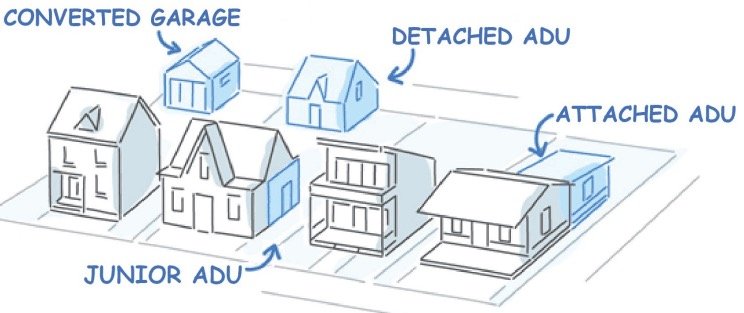
Discover the Benefits of ADUs in SLO
Choose SLO County Realty and receive expert guidance on how Accessory Dwelling Units can enhance your property and generate additional income.
What is an Accessory Dwelling Unit (ADU)?
An Accessory Dwelling Unit (ADU) is a secondary, self-contained residential structure located on the same property as a primary residence. There are four different variations of ADUs including detached, attached, converted, and JADUs. These structures are intended to be independent living facilities for one or more persons allowing for additional living space and rental opportunities.
Benefits Overview
Housing Flexibility: ADUs can provide additional space for family members, guests, caregivers, or new tenants.
Increased Property Value: A newly built ADU can be a smart long-term investment in San Luis Obispo, as new constructions generally sell for significantly higher prices than existing homes due to increased functionality and aesthetic appeal.
Support Local Housing Needs: ADUs help address the housing shortage in San Luis Obispo by providing affordable housing options.
Additional Rental Income: By adding an ADU to the property, homeowners can generate more revenue by renting out the extra space to new tenants.
Our ADU on Gerda Street in San Luis Obispo!
THE FOUR TYPES OF ADUs
Converted:
Part of the primary residence is converted into an independent living unit. This includes spaces such as garages, covered carports, master bedrooms, and more.
Detached:
The unit is separate or detached and does not share any walls with the primary dwelling. This type of ADU could be in the form of a new construction or a conversion of a detached structure.
JADU (Junior ADU):
A specific type of converted unit that is a maximum of 500 square feet and contained entirely within the main residence.
Attached:
The unit is constructed as an addition to the primary dwelling and shares a common wall.
Our ADU on Serrano Dr In San Luis Obispo!
Regulations for Converted, Detached, and Attached ADUs
ADUs in the City of San Luis Obispo follow state regulations and guidelines:
Lot size can be any size.
The permitted zones are AG, C/OS, R-1, R-2, R-3, R-4, or 0.
The minimum gross size is 150 sq ft, and the maximum size allowed for a studio or 1 bedroom is 850 sq ft. For a 2+ bedroom configuration, an ADU can be up to 1,000 sq ft, or up to 1,200 sq ft with a Director's Action, limited to R-1 lots of at least 12,000 sq ft.
The setbacks for ADUs limited to 16' in height are 4' side and rear yard setbacks, and standard development setbacks would apply for additional height.
The maximum height is 16', or 25' with setback standards applied.
The architectural style and exterior materials of an accessory dwelling unit should match the existing residence.
Fire sprinklers are not required if the main residence doesn't require them.
No additional parking spaces are required for an accessory dwelling unit. If a garage or carport is converted or removed, replacement parking is not required.
For accessory dwelling units created within an existing structure, no new utility connection or payment of impact fees shall be required. For all other accessory dwelling units, a new utility connection and payment of impact fees may be required if the accessory dwelling unit is 750 sq ft or more. New accessory dwelling units located in sewer capacity-constrained areas are subject to Section 13.08.396 (Wastewater flow offset).
An accessory dwelling unit that meets the standards contained in this section shall be subject to ministerial review and approval without discretionary review or public hearing.
An accessory dwelling unit cannot be rented for less than thirty days, and homestay use of an accessory dwelling unit is prohibited.
Regulations for Junior ADUs
Differences in regulations for JADUs as opposed to the other types of ADUs:
The properties must be zoned for residential use only.
The maximum gross size allowed for a Junior Accessory Dwelling Unit (JADU) is 500 sq ft, and it must be created within the walls of a proposed or existing primary dwelling.
It's important to note that a JADU is not considered a dwelling unit for density purposes.
No additional parking is required for a JADU. However, if an existing garage is converted into a JADU, replacement parking must be provided according to Sections 17.70.170 (Setbacks) and 17.76.040 (Front yard parking).
The owner of the property must occupy either the primary residence or the junior accessory dwelling unit.
Before building permits are issued for a JADU, a covenant agreement must be recorded, stating the structure's approved floor plan and status as a "junior accessory dwelling unit." The agreement also confirms that the owner of the property will occupy either the primary residence or the junior accessory dwelling unit. This agreement shall be recorded in the county recorder's office to provide notice to all future property owners.
A separate exterior entry is required for a JADU, and the interior access may remain or be removed. An efficient kitchen is required at minimum.
Our ADU on Murray Ave In San Luis Obispo!
Our Services
Property Evaluation
Assess your property's suitability for ADU development based on local regulations an
Design and Planning
Connect with experienced designers and architects to create an ADU that meets your needs and complies with local regulations.
Permit Assistance
Navigate the permitting process with expert guidance, ensuring a smooth and successful ADU project.
Financing Options
Explore various financing options to fund your ADU project, including loans, grants, and incentives.
Construction & Project Management
Coordinate with trusted builders and contractors to ensure a high-quality and timely ADU construction.
Marketing and Leasing Support
Maximize your ADU's rental potential with expert marketing strategies and tenant screening services.
Please allow us to provide, at no cost to you
A Free Custom ADU Report specifically written for your property
that includes this information for your ADU!
o ADU Design Standards
o Allowed Height for Your Property
o Minimum & Maximum Size Allowable ADU
o Front & Rear Setbacks (Min)
o Estimated Cost
o Construction Type
o Site Conditions Review (Slope, Soils, etc)
o Utility Upgrades
o Sale and Rental Restrictions
o Lot Area In Square Feet
o Area Of Primary Residence
o Area Of Other Structures
o Total Ground Floor Area
o ADU Design Standards
805-305-9662
FAQs
What is the cost of building an ADU in San Luis Obispo?
The cost of building an ADU can vary greatly depending on factors such as size, materials, design, and location. On average, ADU construction costs range from $150 to $300 per square foot. It's important to consult with a professional to get an accurate estimate for your specific project.
What financing options are available for building an ADU on my property?
Financing the construction of an ADU on your property can be achieved through various methods, including construction loans, temporary-to-permanent loans, and personal loans. A construction loan is a brief loan that can be refinanced once the construction is finished. A temporary-to-permanent loan is a construction loan that lasts throughout the construction phase and then converts into a conventional mortgage when the house is completed. The benefit of these loans is that you only have to close on one mortgage instead of two, which is required with a standalone construction loan. Lastly, personal loans can be useful because many personal lenders allow you to borrow up to $100k with no down payment. Additional advantages of personal loans for ADU construction include quicker amortization periods compared to standard mortgages, borrower-based underwriting rather than property-based, and speedy approval times.
Do I need a permit to build an ADU on my property?
Yes, you will need a permit to build an ADU in San Luis Obispo. Permit requirements may include site plans, architectural drawings, and other documentation to ensure compliance with local regulations. Under current California law, the maximum review time for an ADU or JADU permit application is 60 days. Our experts at SLO County Realty can help you navigate the permitting process.
How long does it take to build an ADU?
The time it takes to build an ADU depends on factors such as design complexity, permitting, and construction schedules. On average, the entire process, from planning to completion, can take anywhere from 6 to 18 months.
Does adding an ADU impact my property taxes?
Your property tax will see a minor uptick as a result of the increased worth of the ADU, while the underlying value of your property will remain unchanged. To illustrate, suppose the ADU raises the value of your property by $200,000 and your property tax rate is 1.1%; in that case, your property tax would go up by $2,200 ($200,000 x 1.1%).
What People Are Saying…
“You can tell he just loves what he does. It wasn't just a business transaction.”
Colleen Sarksian
“One of the most notable characteristics about Ken is his passion. He cares about the work that he does and he’s very easy to talk to and connect with. ”
Mayra Paniagua




